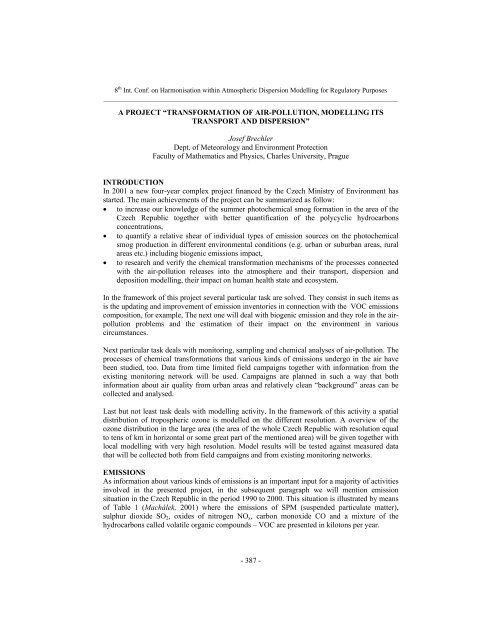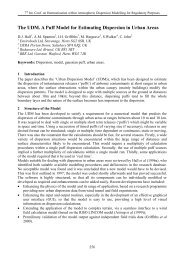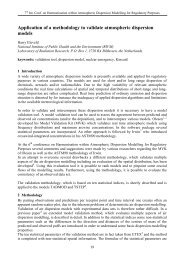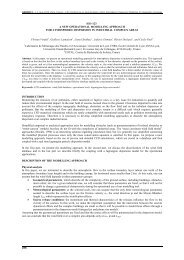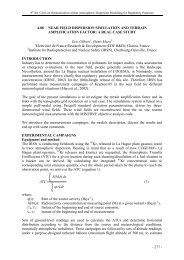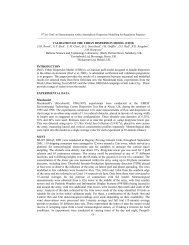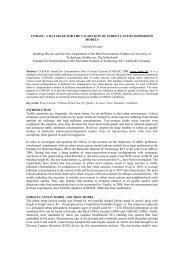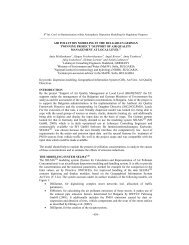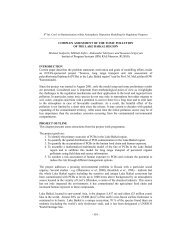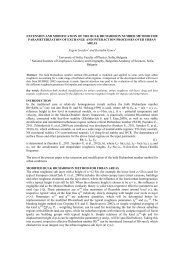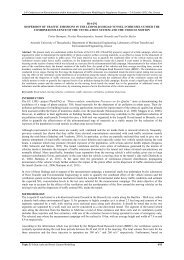- 387 - A PROJECT “TRANSFORMATION OF AIR-POLLUTION ...
- 387 - A PROJECT “TRANSFORMATION OF AIR-POLLUTION ...
- 387 - A PROJECT “TRANSFORMATION OF AIR-POLLUTION ...
Create successful ePaper yourself
Turn your PDF publications into a flip-book with our unique Google optimized e-Paper software.
8 th Int. Conf. on Harmonisation within Atmospheric Dispersion Modelling for Regulatory Purposes<br />
______________________________________________________________________________________<br />
A <strong>PROJECT</strong> <strong>“TRANSFORMATION</strong> <strong>OF</strong> <strong>AIR</strong>-<strong>POLLUTION</strong>, MODELLING ITS<br />
TRANSPORT AND DISPERSION”<br />
Josef Brechler<br />
Dept. of Meteorology and Environment Protection<br />
Faculty of Mathematics and Physics, Charles University, Prague<br />
INTRODUCTION<br />
In 2001 a new four-year complex project financed by the Czech Ministry of Environment has<br />
started. The main achievements of the project can be summarized as follow:<br />
• to increase our knowledge of the summer photochemical smog formation in the area of the<br />
Czech Republic together with better quantification of the polycyclic hydrocarbons<br />
concentrations,<br />
• to quantify a relative shear of individual types of emission sources on the photochemical<br />
smog production in different environmental conditions (e.g. urban or suburban areas, rural<br />
areas etc.) including biogenic emissions impact,<br />
• to research and verify the chemical transformation mechanisms of the processes connected<br />
with the air-pollution releases into the atmosphere and their transport, dispersion and<br />
deposition modelling, their impact on human health state and ecosystem.<br />
In the framework of this project several particular task are solved. They consist in such items as<br />
is the updating and improvement of emission inventories in connection with the VOC emissions<br />
composition, for example, The next one will deal with biogenic emission and they role in the airpollution<br />
problems and the estimation of their impact on the environment in various<br />
circumstances.<br />
Next particular task deals with monitoring, sampling and chemical analyses of air-pollution. The<br />
processes of chemical transformations that various kinds of emissions undergo in the air have<br />
been studied, too. Data from time limited field campaigns together with information from the<br />
existing monitoring network will be used. Campaigns are planned in such a way that both<br />
information about air quality from urban areas and relatively clean “background” areas can be<br />
collected and analysed.<br />
Last but not least task deals with modelling activity. In the framework of this activity a spatial<br />
distribution of tropospheric ozone is modelled on the different resolution. A overview of the<br />
ozone distribution in the large area (the area of the whole Czech Republic with resolution equal<br />
to tens of km in horizontal or some great part of the mentioned area) will be given together with<br />
local modelling with very high resolution. Model results will be tested against measured data<br />
that will be collected both from field campaigns and from existing monitoring networks.<br />
EMISSIONS<br />
As information about various kinds of emissions is an important input for a majority of activities<br />
involved in the presented project, in the subsequent paragraph we will mention emission<br />
situation in the Czech Republic in the period 1990 to 2000. This situation is illustrated by means<br />
of Table 1 (Machálek, 2001) where the emissions of SPM (suspended particulate matter),<br />
sulphur dioxide SO 2 , oxides of nitrogen NO x , carbon monoxide CO and a mixture of the<br />
hydrocarbons called volatile organic compounds – VOC are presented in kilotons per year.<br />
- <strong>387</strong> -
8 th Int. Conf. on Harmonisation within Atmospheric Dispersion Modelling for Regulatory Purposes<br />
______________________________________________________________________________________<br />
Table 1. Emissions in the Czech Republic in 1990 - 2000 (in kt/year).<br />
Year SPM SO 2 NO x CO VOC's<br />
1990 631 1876 742 1055 435<br />
1991 592 1776 725 1102 398<br />
1992 501 1538 698 1045 359<br />
1993 441 1419 574 967 338<br />
1994 355 1278 434 1026 310<br />
1995 201 1091 412 874 286<br />
1996 179 946 432 886 284<br />
1997 128 701 423 877 272<br />
1998 86 443 413 767 269<br />
1999 67 269 390 686 248<br />
2000 57 265 397 649 240<br />
The above presented Table 1 gives an absolute value of emissions. Next important information<br />
is an emission per one square km per year. This value can be issued also as an emission per one<br />
square km per year per capita in order it could be possible to compare different states, for<br />
example. In the Czech Republic the emissions per one square km per year were in 1999 as they<br />
are written in Table 2 (Machálek, 2001).<br />
Table 2. Emissions per one square km per year in the Czech Republic in 1999 in kt/year.<br />
Area (km 2 Population<br />
)<br />
SPM SO<br />
density<br />
2 NO x CO VOC's<br />
78866 131 0.8 3.4 4.9 8.7 3.4<br />
The following Table 3 (Machálek, 2001) shows the expected situation in the emissions of SO 2 ,<br />
NO x and VOC's in 2010 from individual categories of emission sources. Emissions from<br />
stationary emission sources can be found in emission inventories REZZO 1, REZZO 2 and<br />
REZZO 3 where REZZO 1 contains the most powerful point sources (stacks of power plants,<br />
heating plants, industrial sources, for example), REZZO 2 are the medium emission point<br />
sources (block heating plants or small factories, for example) and REZZO 3 deals mainly with<br />
local heating sources. Mobile sources are documented in the REZZO 4 inventory.<br />
Table 3. Expected emissions from individual categories of emission sources in 2010.<br />
Emission sources category SO 2 NO x VOC's<br />
kt/year % kt/year % kt/year %<br />
REZZO 1 171 71 110 38<br />
REZZO 2 10 4 6 2<br />
REZZO 3 42 18 10 4<br />
Sum of stationary sources 224 93 126 44 150 64<br />
Mobile sources 17 7 160 56 70 36<br />
Sum of all sources 241 100 286 100 220 100<br />
Given upper limit for 2010 283 286 220<br />
- 388 -
8 th Int. Conf. on Harmonisation within Atmospheric Dispersion Modelling for Regulatory Purposes<br />
______________________________________________________________________________________<br />
In all the above mentioned tables the VOC's emissions are presented as a single value without<br />
any additional information about the composition of this group of hydrocarbons. This<br />
information is very important especially for modelling as the property of individual compounds<br />
in the whole amount of VOC's can differ significantly. As far as this problem concerned it can<br />
be said that:<br />
• a spectrum of VOC's from combustion processes is significantly different from that of<br />
evaporation,<br />
• this spectrum depends also on the kind of petrol used,<br />
• there is a great difference when oil is used as a fuel.<br />
This fact can be illustrated by comparison of species creating VOC sampled in different places<br />
in the Czech Republic (see, for example, Leníček, 1997). These places differ mainly in the<br />
industry structure and the traffic intensity and kinds of cars (passenger cars, heavy lorries etc).<br />
There are significant differences in concentrations of some compounds as toluene, for example.<br />
The above information deals with emissions due to human activity. Biogenic emissions are not<br />
involved in the above mentioned information. On the other hand it is well known that the<br />
biogenic emissions of CO from forests can be quite high and, for example, isoprene together<br />
with other organic compounds is also emitted significantly from the coniferous forests.<br />
FIELD CAMPAIGNS<br />
To improve our knowledge about the role of biogenic emissions on the formation of ground<br />
level photooxidative air-pollution (mainly ozone) several field campaigns are planned and they<br />
will occur at several places. The results of analyses from these campaigns could help us to better<br />
understand all processes in the atmosphere that the emissions of different hydrocarbons have to<br />
undergo. When we will be able to describe them then it will be possible to improve the<br />
description of chemical reactions the consequences of which are the high concentrations of socalled<br />
summer photochemical smog.<br />
As there can be various circumstances that can affect photochemical smog creation several<br />
different places for measurement were chosen. They could represent various types of<br />
environment one can meet. There will be a monitoring activity in such a site, that can represent<br />
an urban environment with industry, traffic and other, for urban environment typical activities<br />
and, of course, also typical composition of emissions. Another monitoring activity will take part<br />
in relatively clean condition far distant from heavy traffic and cities and towns. Data collected<br />
from these field campaigns could help us to understand better and better describe atmospheric<br />
chemistry, as it has been written above.<br />
MODELLING<br />
Modelling activity in the framework of the mentioned project mainly deals with distribution of<br />
ground concentration of photooxidative air-pollution that can be represented with tropospheric<br />
ozone O 3 . To model this distribution it is necessary to couple the chemical submodel with some<br />
meteorological pre-processor that would generate necessary meteorological information as flow<br />
field, temperature distribution, information about vertical temperature stability, for example.<br />
Now, the system consisting of the meteorological ETA model (Mesinger et al., 1988) and a<br />
chemical submodel SMOG (Bednář et al., 2001) has been tested for the problems on mesoscale.<br />
Chemical submodel SMOG has been developed at the Department of Meteorology and Env.<br />
Protection, Faculty of Mathematics and Physics, Charles University, Prague, meteorological<br />
prognostic model ETA is that used by the US NCEP and now it is routinely run at the same<br />
department. In the next future another possibilities consisting of mesoscale model MM5 (Grell et<br />
- 389 -
8 th Int. Conf. on Harmonisation within Atmospheric Dispersion Modelling for Regulatory Purposes<br />
______________________________________________________________________________________<br />
al., 1994) coupled with air-pollution model CAMx (User’s guide, 1998) is planned to be tested<br />
together with a system consisting of mesoscale model METRAS (Schlünzen et al., 1996) and<br />
submodel SMOG. Mesoscale model METRAS has been developed at the Meteorological Institute<br />
of Hamburg University.<br />
A very local high resolution modelling of the spatial distribution of O 3 concentration in the areas<br />
close to selected locations where field campaigns takes part is also prepared. To solve this task a<br />
new CFD model able to describe local factors affecting distributions of meteorological elements<br />
is prepared.<br />
CONCLUDING REMARKS<br />
Despite the improving situation in so-called “classic” emissions (like SPM or SO 2 ) release,<br />
there remain problems having their origin in the past where the emission of these species were<br />
high in due to this fact also depositions were high and this led to the degradation of ecosystems.<br />
Another problem comes from the fact that there are still high emissions of species originating in<br />
car traffic which results in the photooxidative smog creation in summer months. To understand<br />
better all these processes the result of which is the photooxidative smog and to describe better<br />
the impact this kind of air-pollution on living systems is one task of the presented project.<br />
The second task comes from the fact that up to now only impact of emissions originating in<br />
human activity was taken into account. But there are a lot of, let us say, natural emissions<br />
coming from forests, for example, that are also quite important. They have to be taken into<br />
account into studies of the emission impact as they can act together with “human activity”<br />
emissions and intensify this impact. This is also a part of the presented project.<br />
ACKNOWLEDGEMENT<br />
This work has been performed in the framework of the project VaV/740/2/01 financed by the<br />
Ministry of Environment of the Czech Republic.<br />
REFERENCES<br />
Bednář, J., Brechler, J., Halenka, T. and Kopáček, J., 2001: Modelling of Summer<br />
Photochemical Smog in the Pratur Region, Phys. Chem. Earth (B), 6, 129 – 136.<br />
ENVIRON International Corp., 1998: User’s Guide: Comprehensive Air Quality Model with<br />
Extension (CAMx). Version 2.00., Novato, California 94945-5010.<br />
Grell, G.A., Dudhia, J., Stauffer, D.R., 1994: A Description of the Fifth-Generation Penn/Srate<br />
/NCAR Mesoscale Model (MM5), NCAR Technical Note, NCAR/TN-398 + STR.<br />
Leníček, J.,. Sekyra, M., Kociánová, S., Novák, J., Beneš, I., 1997: Determination of VOC in<br />
some locations of the Czech Republic, Air Protection, 2, 10 – 12 (in Czech).<br />
Machálek, P., 2001: Trends in air-pollution in the years 1990 – 1999. In Proc.: Atmosphere<br />
2001, Brno, 2001 (in Czech).<br />
Mesinger, F., Janjić, Z., Nickovič, S., Gavrilov, D., Deaven, D.G.,1988: The step-mountain<br />
coordinate: Model description and performance for cases of Alpine lee cyclogenesis<br />
and for a case of an Appalachian redevelopment. Mon. Wea. Rev.,116, 1493 – 1518.<br />
Schlünzen, K. H., Bigalke, K., Lenz, C.-J., Lüpkes, Ch., Niemeier, U., von Salzen, K., 1996:<br />
Concept and Realuization of the Mesoscale Transport and Fluid Model ´METRAS´,<br />
Universität Hamburg, 1996.<br />
- 390 -


